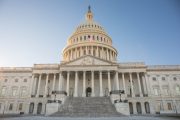
The first time Rep. Paul Ryan (R-Wisc.) offered his “Roadmap for America’s Future” to the House of Representatives, it failed by 137-293, with 38 Republicans voting against, including Rep. Ron Paul (R-Texas). With his own district safe in the fall elections, Ryan has been spending his time generating support for Roadmap II with presentations to conservative think tanks and coffee klatches.
And he seems to be gaining some traction along with a lot of fresh attention. His plan aims to erase entirely the federal debt by the year 2063 by simplifying the tax code, and modifying both Medicaid and Social Security. He no longer considers such discussions as “the third rail” of politics: “I don’t think these things are third rails anymore. People are ready for this.”
The New York Times agrees: “Like many other politicians whose ideas were once considered extreme, only to later [become] mainstream — like Ronald Reagan — Mr. Ryan is seen as on the leading edge of something.” The Philadelphia Inquirer was almost giddy: “It’s especially important to get in the game now. Crippling deficits have the attention of Americans as never before, and many are open to a serious alternative to the nation’s unsustainable fiscal course…the safety net [Ryan] outlines…doesn’t bankrupt the country…but will [according to the Congressional Budget Office] make the Social Security and Medicare programs permanently solvent [and] lift the growing burden on future generations. The ‘Never Enough [Government]’ crowd naturally doesn’t want the limits that Ryan proposes. That’s enough of an endorsement for me.”
Jonah Goldberg in the Los Angeles Times considers Ryan’s Roadmap as “a realistic reform plan” which is designed to reflect current reality.
The Wisconsin Republican’s Roadmap is not a "reactionary" document, as the left usually describes most anything that involves substantially reducing the size, scope and cost of government. It doesn’t seek to turn back the clock. Rather, it breaks with a strain of libertarian logic that is always at war with the State, while staying true to the idea that the best government is the one that governs least. It advances libertarian ends by admitting the limits of libertarian means.
Goldberg adds that “the key to Ryan’s do-over is acknowledging that Americans will never eradicate the welfare state entirely for the simple reason that Americans don’t want to eradicate the welfare state entirely … [Ryan’s] document is a monumental concession to political reality.”
The major components of Ryan’s Roadmap are:
1. A simple two-tier, low-rate personal income tax system: 10 percent on the first $100,000 of income for couples ($50,000 for singles) and 25 percent above that. It abolishes the Alternative Minimum Tax and eliminates loopholes and credits except for generous personal and family deductions. The corporate income tax code would be replaced with an 8 ½ percent value-added-tax or corporate consumption tax, and all business investments would be expensed immediately.
2. When it comes to healthcare, the Roadmap is predicated upon the repeal of Obamacare. In its place, Roadmap would shift the ownership of health coverage to individuals, and would provide a refundable tax credit — $2,500 for individuals and $5,000 for families — to purchase coverage.
3. Everyone currently aged 55 or over would remain in Medicare, but those currently under 55 — as they become Medicare-eligible — would receive a Medicare payment, initially averaging $11,000, to be used to purchase a Medicare certified plan.
4. Ryan’s plan for Social Security employs a private option to anyone under age 55 that would allow them to put a third of their payroll taxes into a private account, to be managed by the Social Security Administration. These private accounts would belong to the individual worker and would be fully inheritable.
When the Congressional Budget Office first ran the numbers on Ryan’s Roadmap, it said “The Roadmap…would result in less federal spending for Medicare and Medicaid as well as lower tax revenues…Those changes would reduce federal budget deficits and the federal debt. Under the proposal, federal outlays…would decline from 26 percent of GDP in 2009 to 19 percent in 2020, 16 percent in 2060, and 14 percent in 2080….The lower budget deficits under [the Roadmap] would result in much less federal debt…and thereby a much more favorable macroeconomic outlook…The economy would be considerably stronger under [the Roadmap] than it [otherwise] would be…Real gross national product per person would be about 70 percent higher in 2058 under [the Roadmap]…” In a followup letter to Rep. Ryan, those estimates were tempered considerably.
Ryan himself says that his plan “isn’t a plan for austerity and pain. It’s a prudent, temperate, achievable, and modest plan for prosperity….” Others are less enthusiastic, pointing out that the Social Security Administration would still be managing the entire system, even those “private” accounts. A key part of his proposal assumes that Obamacare will in fact be repealed. And the introduction of a value-added-tax (VAT) on corporations opens the door for the extension of such a tax on every consumer. The Democratic Underground considers Ryan’s Roadmap as “a serious reform proposal to address the surging middle-class entitlements that threaten our children’s economic future … we challenge those who disagree with his approach to offer their own long-term solution." Even Will Marshal, president and founder of the Progressive Policy Institute (PPI) points out that there’s “an honesty” in Ryan’s plan that “doesn’t exist in the general Republican agenda.”
While such legislation is likely to face tough sledding at the moment, Rep. Devin Nunes (R-Calif.) who has supported Ryan’s Roadmap from the first, says that candidates will very soon be forced to take a position on such a proposal, especially those candidates who are running on fiscally responsible platforms. Says Nunes, “The deficit isn’t going away, the entitlements aren’t getting better, and it’s tough times out there. The presidential candidates are going to have a problem with this.”
The second iteration of Ryan’s Roadmap is setting the stage for a serious discussion of the nation’s fiscal difficulties. It could get some legs as the November elections draw closer, and may even provide a litmus test for those politicians who claim in the their campaign rhetoric that they want to reduce the deficit. As The Economist said:
[Ryan’s Roadmap] deserves credit for an honest and daring proposal. Tellingly, his plan has faced criticism from both parties. Republican leaders have been careful to distance themselves from the slashing of programmes dear to one of their core constituencies. If nothing else, Mr. Ryan has reminded everyone of the hard choices that will soon have to be made.
Photo: U.S. Rep. Paul Ryan, 40, speaks during a listening session at Gateway Technical College in Kenosha, Wis., on June 3, 2010: AP Images

